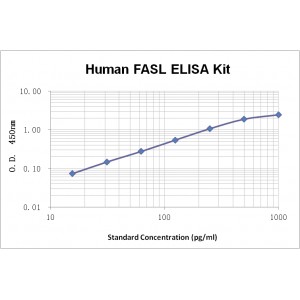More info
Assay Range | 15.6--1000 pg/mL |
Sensitivity | 2.0 pg/mL |
Specificity | No cross-reaction with other related substances detected |
Size | 96T |
Storage | Store at 2 - 8ºC. Keep reconstituted standard and detection Ab at -20 ºC |
Assay Principle | Sandwich ELISA |
Sample Volume | 100 µL final volume, dilution factor varies on samples |
Sample Type | serum, plasma or cell culture supernatant |
Detection Method | Chromogenic |
Kit Components
1. Recombinant Human FASL standard: 2 vials
2. One 96-well plate coated with Human FASL Ab
3. Sample diluent buffer: 12 mL - 1
4. Detection antibody: 130 µL, dilution 1:100
5. Streptavidin-HRP: 130 µL, dilution 1:100
6. Antibody diluent buffer: 12 mL x1
7. Streptavidin-HRP diluent buffer: 12 mL x1
8. TMB developing agent: 10 mL x1
9. Stop solution: 10 mL x1
10. Washing solution (20x): 25 mL x1
Background
Fas ligand (FasL), also known as TNFSF6, CD178, or CD95L, is a type-II transmembrane protein that belongs to the tumor necrosis factor (TNF) family. The full-length FasL protein is a 281 amino acid (aa) polypeptide from which four truncated forms of FasL, including membrane form of tumor necrosis factor ligand superfamily member 6, soluble form of tumor necrosis factor ligand superfamily member 6 (receptor-binding FasL ectodomain, soluble Fas ligand, sFasL), ADAM10-processed FasL form (APL) and FasL intracellular domain (FasL ICD, SPPL2A-processed FasL form (SPA)), could be generated by proteolysis. FasL shares 76.9% aa sequence identity with mouse FasL. FasL is constitutively expressed primarily in activated T lymphocytes and immune-privileged tissues including eye, testis, and placenta. FasL binds to its receptor Fas to initiate a series of apoptotic cascades which are essential to the regulation of immune system. In addition, FasL can bind the Decoy receptor 3 (DcR3) which can prevent binding of Fas with the membrane-bound FasL and thus inactivate FasL/Fas triggered apoptosis.


